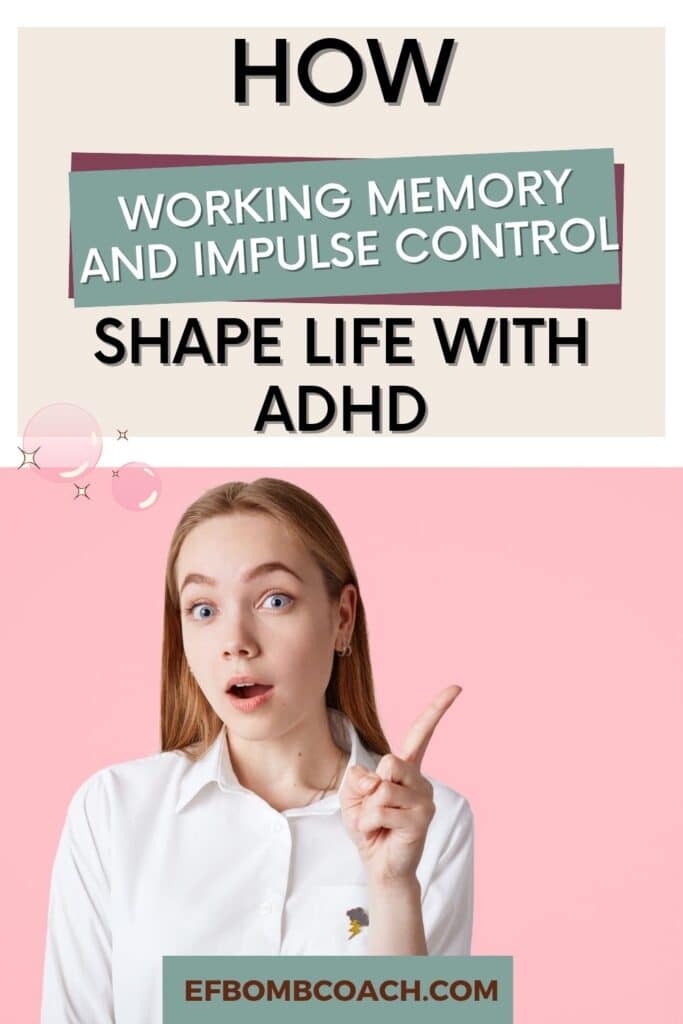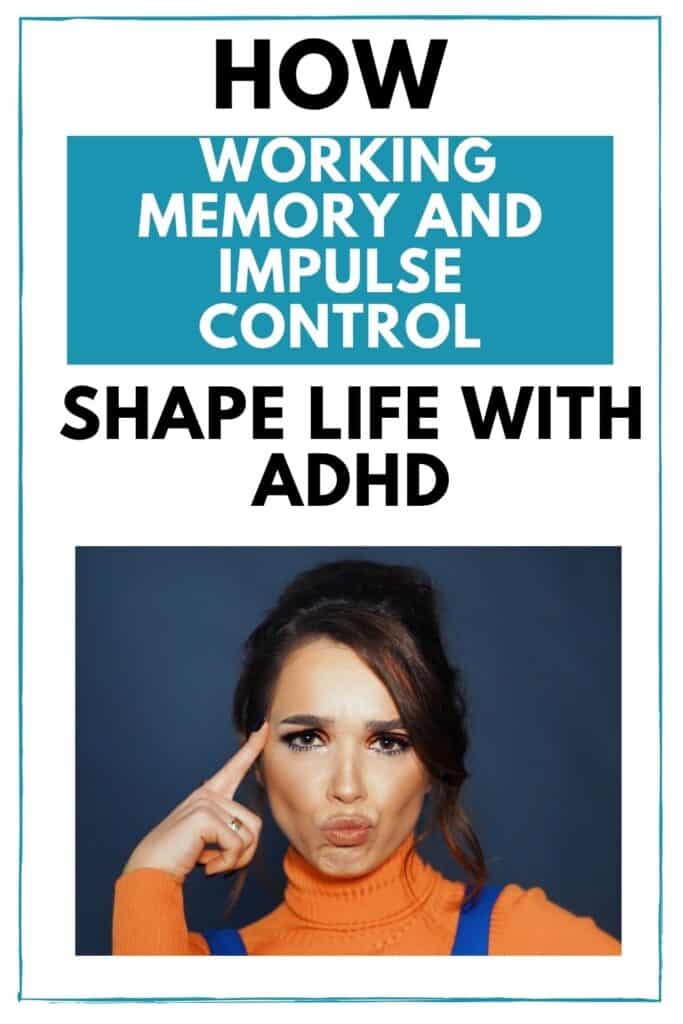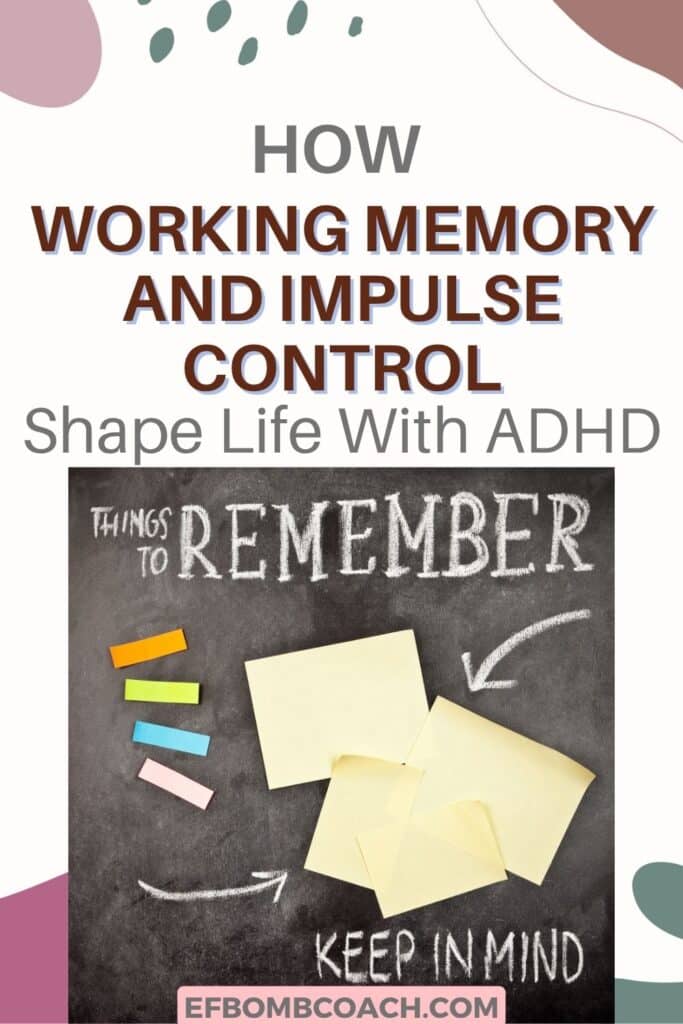How Working Memory and Impulse Control Shape Life With ADHD
Do you ever feel like your mind hops from one thing to the next without warning? That pull to act on sudden ideas or speak before you’ve thought it through— that’s impulse control.
Prefer to listen rather than read? Press play below.
And then there’s working memory: that mental sticky note you rely on to remember, focus, and hold onto new info. If you’re a neurodivergent woman with ADHD, you already know how these two can clash, adding extra stress to everyday life.
Understanding how working memory and impulse control connect is about finding better ways to handle tough moments. Together, they shape your choices, reactions, and even the way you see yourself.
Knowing how these parts of your brain work can give you fresh tools to create real change, instead of settling for more chaos.
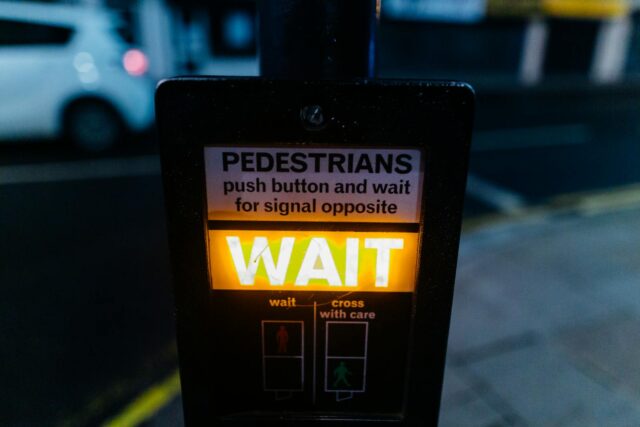
What Is Working Memory and Why Does It Matter in ADHD?
Most neurotypical people take it for granted when they remember a phone number just long enough to dial, juggle a shopping list in their heads, or follow a set of directions.
For women with ADHD, these tasks can feel like you’re trying to carry water in your hands. Working memory is the mental sticky note that holds bits of info while you use them, helping you stay focused, control impulses, and finish what you start.
Problems here can lead to that quick-to-act feeling and “oops, I forgot” moments that keep stacking up.
Working Memory and Its Role in Daily Life
Working memory is like a temporary workspace in your brain, holding and managing the info you need right now. Imagine cooking a recipe. You have to remember the next step, measure the right amount, and not forget that you just added salt. That’s working memory in action.
You use working memory when you:
- Do mental math in your head
- Keep track of what someone is saying during a conversation
- Remember a reason you walked into a room, even with distractions
- Hold a plan in mind while your day keeps throwing curveballs
When working memory slips, you end up retracing your steps, losing track of plans, getting interrupted by outside noise, or blanking out on simple things. This is more than forgetfulness; it's about the struggle to hold and juggle information long enough to use it before it’s gone.
How ADHD Affects Working Memory Function
If you have ADHD, you probably know that your brain doesn’t always hold onto information as tightly as you want. The connection between working memory and impulse control is a big reason why you might act before you think or start things you forget to finish.
Researchers found that people with ADHD often lose track of short-term details, like what the teacher just said or which part of a multi-step task you were on.
This isn’t a lack of effort or motivation, but an actual bottleneck in the brain’s working memory system. The harder it is to hold onto details, the quicker your attention drifts and the more your actions get ahead of your thoughts.
Key effects of poor working memory in ADHD include:
- Forgetting tasks mid-way: You get distracted and lose track of steps, so directions and routines fall apart fast.
- Struggling to prioritize: Too much info at once makes it impossible to sort out what matters most.
- Difficulty self-monitoring: You may act on impulses before you remember the rules or your real goals.
Gender Differences: Working Memory in Neurodivergent Women With ADHD
ADHD in women looks different. Many girls and women aren’t diagnosed until adulthood—sometimes after years of feeling “scatterbrained” or “spacey.”
You might manage to hold things together on the outside, but inside, you’re juggling a dozen mental tabs, hoping nothing crashes.
Here’s what often stands out for women:
- Masking and compensation: You might over-prepare, create lists, or lean on reminders so others don’t see lapses in working memory.
- Emotional overload: Forgetting small things can trigger guilt or frustration, especially if you feel responsible for family or work.
- Hidden exhaustion: You might seem organized, but it takes a mountain of effort—or results in burnout.
Because women are socialized to “keep it together,” anxiety and shame can pile up. This can push you to hide your difficulties, leading to more stress and less support.
Research suggests that verbal working memory is often stronger than visual working memory in people with ADHD, especially for women who might use words or stories to remember information. Still, juggling everyday responsibilities—work, home, family—can stretch that verbal memory to the limit.
You don’t have to “work harder” to fit into a mold that wasn’t made for you. Recognizing how working memory impacts impulse control is the first step to getting the right tools and support for how your brain actually works.

Want to learn more about executive functioning? Take my FREE course.
Impulse Control: Understanding the Challenge
Impulse control affects nearly every part of your day when you have ADHD. Think about it like the brakes in your mind—the ability to pause before you act or speak.
When working memory struggles, those mental brakes start to slip. The pull to answer before thinking, splurge when you should save, or jump to a new task before finishing the last one is real, especially for women with ADHD.
These quick reactions aren’t about a lack of willpower or intent. They come from how your brain handles (or drops) information in the moment.
Impulse Control in ADHD: Common Scenarios
If you live with ADHD, it can feel like you’re always in fast-forward. Women often face unique triggers and pressures that shape impulsivity in sneaky ways. Here’s what that might look like in your life:
- Blurting out thoughts before considering the outcome: Cutting off a friend, boss, or partner because your idea feels urgent in the moment.
- Emotional outbursts: Feeling your frustration boil over quickly, especially when you’re tired or juggling too much.
- Impulse shopping or financial decisions: Clicking “buy now” after a long day, chasing that quick hit of relief or pleasure.
- Difficulty managing time: Jumping from task to task, starting three chores at once, and finishing none.
- Interrupting or shifting focus mid-conversation: Your mind races ahead, so you answer questions before they’re finished or change the subject unexpectedly.
Each of these experiences can trigger shame or regret.
Living in a world that rewards calm, careful planning adds to the pressure. If you feel judged for your impulses, you might mask or downplay these moments, but the struggle stays.
The Science Behind Impulse Control Difficulties
Impulse control is more than just trying harder to say no to distractions or temptations. Your brain’s wiring plays a starring role.
For people with ADHD, trouble often starts in the prefrontal cortex, the part that helps you weigh consequences, remember your goals, and slow down your actions.
When working memory is shaky, you lose sight of what matters in the heat of the moment, and automatic reactions take over.
The roots of impulse control problems involve:
- Prefrontal cortex function: This brain region acts like a control tower, managing focus and holding plans in place. In ADHD, the control tower often has spotty signals, making it easy to act before thinking.
- Neurotransmitter imbalances: ADHD is tied to lower activity of brain chemicals like dopamine and norepinephrine, which are key for focus and self-control. Without enough of these messengers, your ability to pause and think ahead drops.
- Reward circuits: Impulsivity can be driven by a craving for fast rewards. Your brain wants instant feedback, not delayed gratification. This explains why impulse shopping or checking your phone pulls so strongly.
Scientists have mapped out these systems in the brain. Studies show that the prefrontal cortex and basal ganglia are major players in impulse control and decision-making. When they’re not firing on all cylinders, keeping impulses in check takes more than sheer effort.
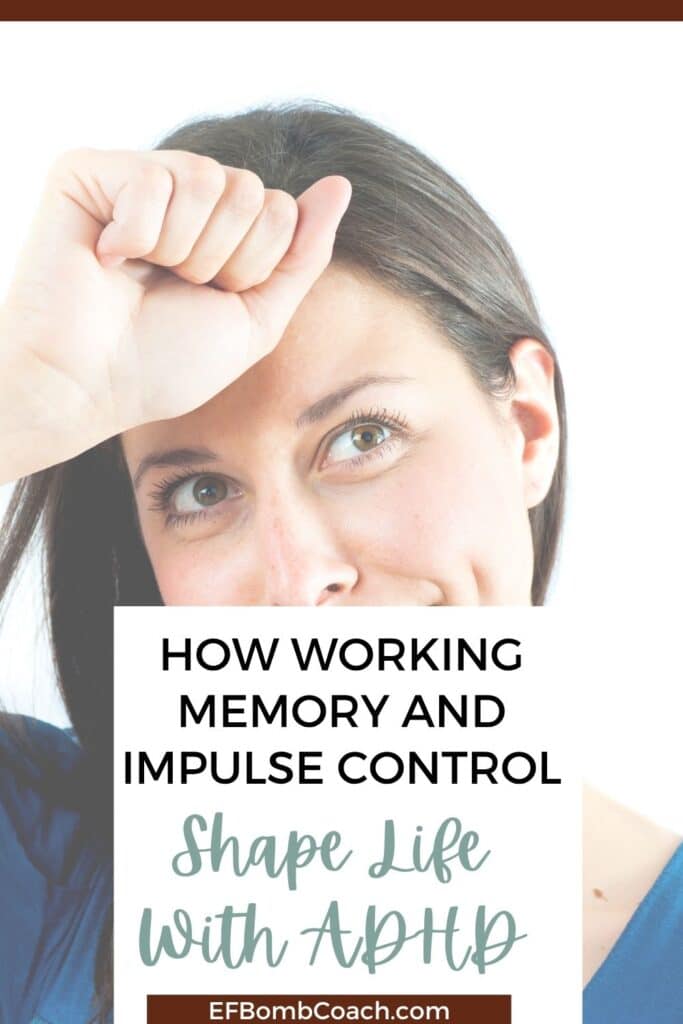
How Working Memory Influences Impulse Control in ADHD
When working memory and impulse control get tangled up, life with ADHD can feel exhausting.
Think of working memory as your brain’s “active to-do list.” If you have ADHD, that list often disappears at the worst times. This gap makes using the brakes on impulse control much harder.
The way these two work together, or don’t, shapes everything from your daily routine to how you manage your emotions and decisions.
The Connection Between Working Memory and Impulse Control
Working memory holds onto rules, reminders, and your longer-term goals. When it’s working right, you remember why you’re waiting in line or what you were about to say.
In ADHD, this mental sticky note fades quickly. The result? It’s much easier to react in the moment instead of pausing, because you literally forget your own rules or intentions.
Science backs this up. Research says that increasing working memory load can make it even harder for people with ADHD to use impulse control, almost like running out of brain battery in the middle of the day.
Research Insights: What the Latest Studies Reveal
New research is starting to map out what’s happening in the brains of people with ADHD when working memory and impulse control are put to the test.
Studies show that central executive working memory—the part that handles active, complex information—tends to be weaker in ADHD. This is a direct roadblock to self-control, planning, and pausing before reacting.
Some recent findings you should know:
- Stronger working memory, better impulse control: When scientists improved working memory in children with ADHD, their ability to pause and think improved, too. Stimulant medication is now shown to help working memory for many people.
- Risky choices tied to memory lapses: One study looked at how people with ADHD make risky financial choices. It turns out, if your working memory is shaky, you focus more on short-term rewards and less on long-term costs. It’s not about wanting to self-sabotage; it’s about losing sight of your earlier plan.
- Future of treatment: Brand new neuro-monitoring approaches help target the working memory deficit right at its source, showing promise in supporting both memory and impulse management.
You don’t have to memorize brain science to know this matters. Every missed appointment, rapid RSVP, or “why did I say that?” moment speaks to the push-pull between your brain’s sticky note and its impulse brakes. Knowing the connection gives you a head start for finding real-life strategies that fit your brain—not someone else’s rulebook.

Did you know I have a membership for women who want to improve their executive function skills? Check it out here.
Supporting Working Memory and Boosting Impulse Control
When working memory and impulse control are out of sync, life can feel like one long string of “why did I do that?” moments. For women with ADHD, these sticky-brain moments add a layer of stress that others might not see. However, daily strategies and practical techniques can make a huge difference.
Everyday Strategies to Strengthen Working Memory
It’s totally normal to forget things here and there, but when your mental sticky note keeps slipping, you need solid, simple habits to back you up.
You don’t have to rely on pure willpower—there are real, doable ways to give your working memory a boost and make daily life less frustrating.
Here are some practical tips to build into your day:
- Break information into smaller chunks. Instead of trying to remember everything at once, focus on one step at a time. For example, if you have a big project, list out micro-tasks.
- Use checklists and visual reminders. Write things down, use sticky notes, set alarms, or decorate your mirror with reminders. Your brain might lose track, but your environment can help.
- Stick to routines. Habits save mental energy. The more you can put daily decisions (like breakfast or leaving your keys in one spot) on autopilot, the less your brain has to juggle.
- Repeat important details. Saying things out loud (or repeating them in your head) actually helps your brain keep hold of them longer.
- Lean heavily on external supports. Calendars, reminder apps, talking aloud to yourself, or setting up cues can all help take the pressure off your memory.
Remember, the goal isn’t to be perfect or to never forget anything. You’re setting up safety nets so your working memory gets a chance to rest.
Techniques to Improve Impulse Control
Struggling to slam on the mental brakes before jumping into action is part of ADHD. But you aren’t stuck with it. You can teach your brain to pause, make space between impulse and action, and give yourself more control—even if it feels impossible sometimes.
Here are some straightforward ways to give your impulse control a lift:
- Make the invisible visible. Notice patterns in your day where impulse control slips (like late at night or when you’re feeling stressed). Awareness is half the battle.
- Create obstacles between you and temptations. Move your phone to another room, use website blockers, or keep snacks out of sight to slow yourself down.
- Practice the “pause.” Before saying or doing something you might regret, count to five or take a slow breath. Even a quick pause can help bring your goals back into focus.
- Build mindful breaks into your day. Activities like breathing exercises, journaling, or just stepping away from a heated moment help reset your brain’s brakes.
- Reward small wins. Every time you succeed in pausing—even just once—celebrate it. Positive feedback does wonders for your self-control.
Building up impulse control is like strengthening a muscle; practice and time really do help, even if progress feels slow at first.
Owning your ADHD journey starts with real knowledge about how working memory and impulse control shape your daily life. Understanding this link gives you a clear path to make meaningful changes.
When you spot the ways your brain drops the thread or reacts too fast, you can talk back to shame and start building habits that fit your needs instead of fighting them.
Remember, you are not stuck in a cycle of missed steps or quick reactions. You have options, support, and real tools that help you pause, regroup, and move forward—one small win at a time.
